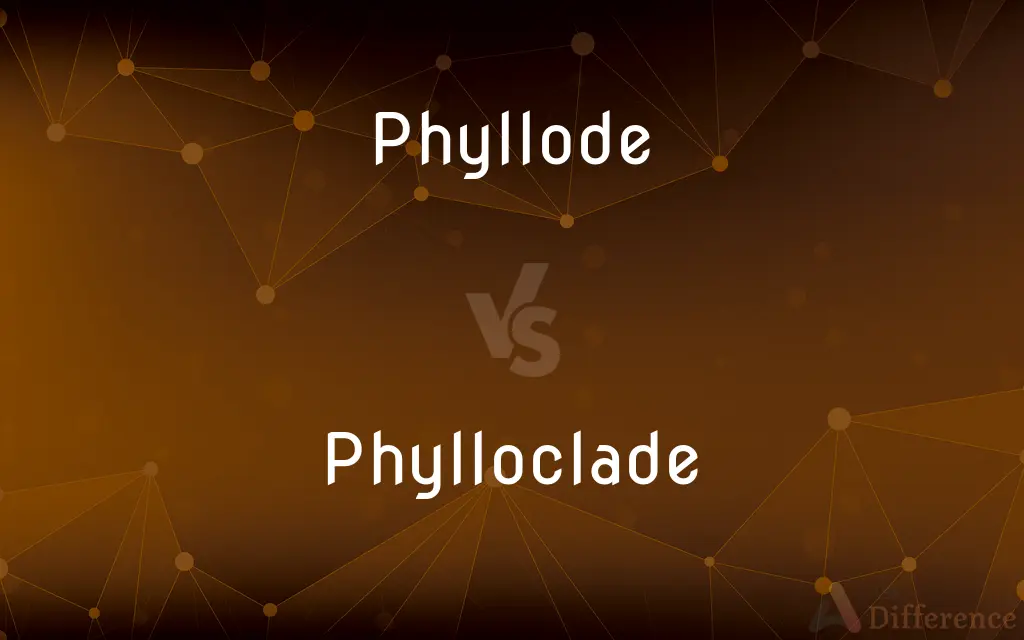Phyllode vs. Phylloclade — What's the Difference?
By Tayyaba Rehman & Fiza Rafique — Updated on March 21, 2024
Phyllode is a flattened leaf stem that functions like a leaf, found in some plants for photosynthesis, while phylloclade is a modified stem that resembles and functions as a leaf, aiding in photosynthesis and water conservation.

Difference Between Phyllode and Phylloclade
Table of Contents
ADVERTISEMENT
Key Differences
Phyllodes arise when the petiole (the leaf's stalk) broadens and takes over the role of the leaf blade, becoming the main site for photosynthesis in some plants, especially in arid regions. In contrast, phylloclades are modified stems that assume the form and function of leaves, often to reduce water loss and maximize photosynthesis under similar conditions.
The primary purpose of phyllodes is to efficiently conduct photosynthesis while minimizing water loss, a vital adaptation in environments where moisture is scarce. Phylloclades, on the other hand, not only perform photosynthesis but also may store water, serving as a dual adaptation to arid conditions.
Phyllodes typically exhibit some characteristics of stems, such as the presence of nodes, but are primarily flat and leaf-like to maximize their surface area for sunlight absorption. Phylloclades can vary more in shape, sometimes appearing as flattened stems or even mimicking the shape of leaves, depending on the species.
In terms of evolution, phyllodes represent an intermediate step between true leaves and more extreme adaptations like phylloclades, suggesting a progression in some plant lineages towards more efficient water use and photosynthetic processes. Phylloclades, being more stem-like, indicate a further step in this evolutionary adaptation, where even the stem is enlisted in the task of photosynthesis.
Plants with phyllodes, such as certain Acacia species, often thrive in environments where water conservation is crucial, leveraging their modified petioles for photosynthesis with minimal water use. Plants with phylloclades, such as some species of cacti and euphorbias, are usually found in even more extreme conditions, where a reduction in the number of true leaves reduces water loss and the modified stems can store water and perform photosynthesis.
ADVERTISEMENT
Comparison Chart
Definition
Flattened leaf stem taking on leaf functions
Modified stem assuming leaf functions
Main Function
Photosynthesis with minimal water loss
Photosynthesis and sometimes water storage
Typical Shape
Flat, leaf-like, with stem characteristics
Varied, including flattened stems or leaf mimics
Evolutionary Role
Intermediate adaptation for efficiency in photosynthesis
Advanced adaptation for water conservation and photosynthesis
Environmental Adaptation
Thrive in arid conditions with minimal water
Suited for extreme arid conditions, reducing water loss
Compare with Definitions
Phyllode
Water Conservation.
Phyllodes minimize water loss by reducing the leaf's surface area.
Phylloclade
Dual Function.
Phylloclades in cacti perform photosynthesis and store water.
Phyllode
Photosynthesis Adaptation.
In acacia plants, phyllodes perform photosynthesis efficiently in dry environments.
Phylloclade
Example Plants.
Certain cacti and euphorbias use phylloclades to survive in desert environments.
Phyllode
Adaptation Feature.
Phyllodes are an adaptation to arid conditions, optimizing water use.
Phylloclade
Evolutionary Adaptation.
Phylloclades represent an evolutionary strategy to thrive in extremely arid conditions.
Phyllode
Example Plants.
Many species of Acacia have developed phyllodes as part of their adaptation.
Phylloclade
Variability in Shape.
Phylloclades can vary greatly in shape, adapting to their environment.
Phyllode
Leaf-Stem Modification.
The petiole of the leaf broadens, assuming the role of the leaf blade.
Phylloclade
Stem Modification.
The stem modifies into a structure resembling a leaf to reduce water loss.
Phyllode
Phyllodes are modified petioles or leaf stems, which are leaf-like in appearance and function. In some plants, these become flattened and widened, while the leaf itself becomes reduced or vanishes altogether.
Phylloclade
Phylloclades and cladodes are flattened, photosynthetic shoots, which are usually considered to be modified branches. The two terms are used either differently or interchangeably by different authors.
Phyllode
A flattened leafstalk that functions as a leaf, as in an acacia.
Phylloclade
A flattened, photosynthetic branch or stem that resembles or performs the function of a leaf; a cladode.
Phyllode
(botany) A flattened petiole or leaf rachis that resembles and functions as a leaf, and may or may not be combined with an actual lamina.
Phylloclade
(botany) A flattened stem, a type of cladode that has unlimited extension growth and resembles a leaf.
Phyllode
Same as Phyllodium.
Phylloclade
A flattened stem resembling and functioning as a leaf
Phyllode
An expanded petiole taking on the function of a leaf blade
Common Curiosities
How do phyllodes and phylloclades contribute to water conservation?
By minimizing the surface area exposed to the air, reducing water loss through transpiration.
What is the main difference between a phyllode and a phylloclade?
Phyllodes are modified leaf stems that function as leaves, while phylloclades are modified stems that take on leaf functions.
Can phyllodes and phylloclades be found on the same plant?
Generally, plants develop either phyllodes or phylloclades, depending on their adaptation strategy.
Why have some plants developed phyllodes?
To perform photosynthesis efficiently with minimal water loss in arid environments.
How do plants with phyllodes or phylloclades adapt to their environments?
They optimize their structures for efficient photosynthesis and water conservation, suitable for arid climates.
What is the significance of the shape variation in phylloclades?
The shape variation helps in maximizing photosynthesis while minimizing water loss, adapted to specific environmental conditions.
Can the presence of phyllodes or phylloclades indicate a plant's habitat?
Yes, their presence often indicates adaptation to arid or semi-arid environments.
What role do phylloclades play in a plant's survival?
They help in photosynthesis and can store water, aiding survival in extremely dry conditions.
Do phylloclades have any other functions besides photosynthesis?
Yes, some phylloclades can store water, providing an additional survival advantage in arid conditions.
Are all desert plants equipped with phyllodes or phylloclades?
Not all, but many desert plants have developed these adaptations to thrive in water-scarce environments.
Are phyllodes considered true leaves?
No, they are modified stems acting as leaves but are not true leaves.
What evolutionary advantage do phylloclades provide?
They offer an advanced adaptation for surviving in harsh, dry climates by minimizing water loss and maximizing photosynthesis.
How do phyllodes differ from normal leaf petioles?
Phyllodes are broader and assume the primary role of photosynthesis, unlike typical leaf petioles.
How does the modification into phyllodes or phylloclades affect a plant's growth?
It can affect growth patterns, optimizing the plant's energy and resources for survival in specific climates.
Is there a way to visually distinguish between a phyllode and a phylloclade?
Yes, by observing their structure; phyllodes are more stem-like and flat, while phylloclades are stem modifications that mimic leaves.
Share Your Discovery

Previous Comparison
Buck vs. Doe
Next Comparison
Waistline vs. WaistAuthor Spotlight
Written by
Tayyaba RehmanTayyaba Rehman is a distinguished writer, currently serving as a primary contributor to askdifference.com. As a researcher in semantics and etymology, Tayyaba's passion for the complexity of languages and their distinctions has found a perfect home on the platform. Tayyaba delves into the intricacies of language, distinguishing between commonly confused words and phrases, thereby providing clarity for readers worldwide.
Co-written by
Fiza RafiqueFiza Rafique is a skilled content writer at AskDifference.com, where she meticulously refines and enhances written pieces. Drawing from her vast editorial expertise, Fiza ensures clarity, accuracy, and precision in every article. Passionate about language, she continually seeks to elevate the quality of content for readers worldwide.














































